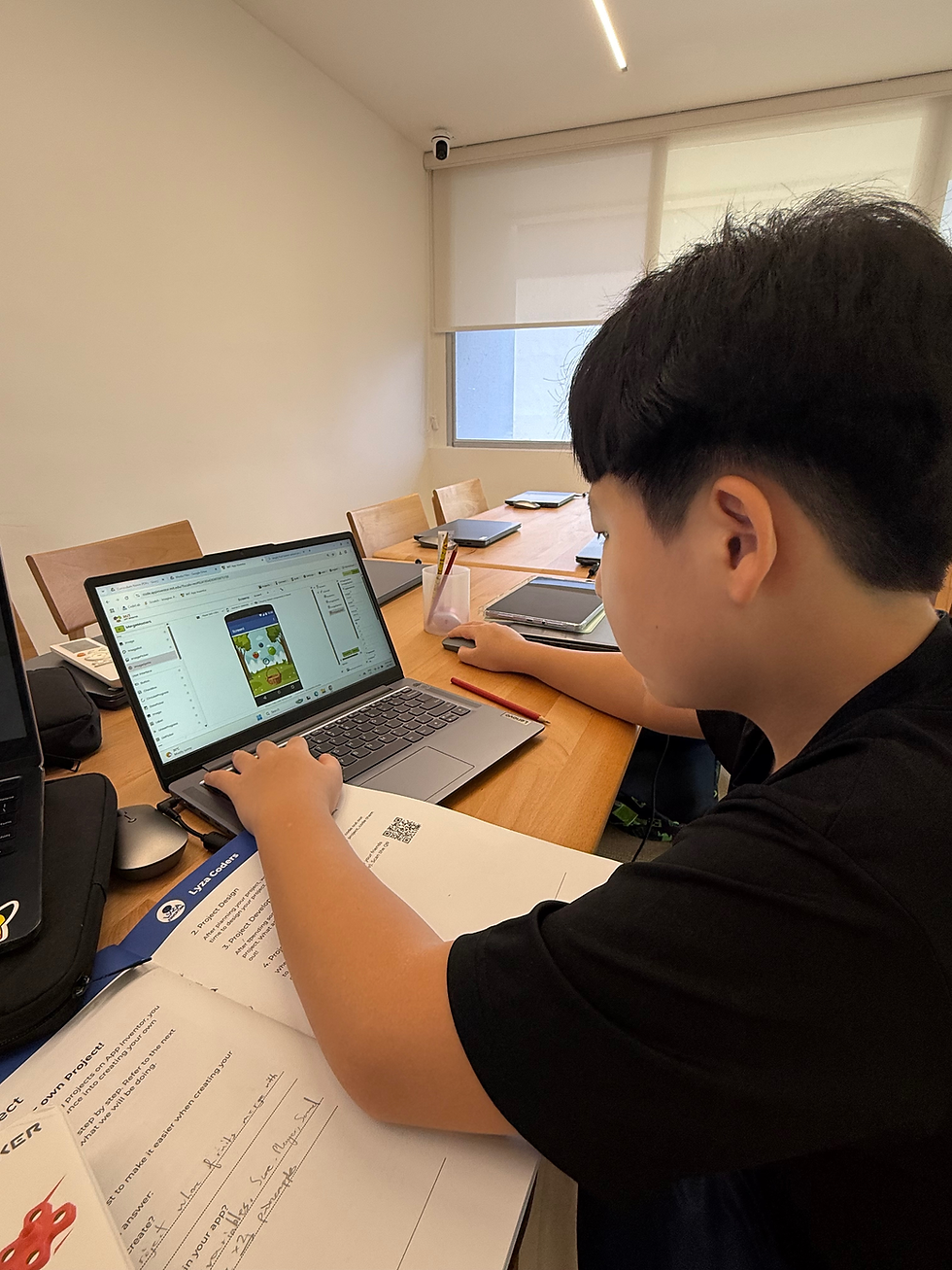Inside Singapore’s Lyza Orchard: Inspiring Design, Tech Upgrades & Child-Centered Creativity
- Lyza Education
- Sep 9
- 4 min read
Lyza Education’s centre in the heart of Singapore over in Orchard. It has been thoughtfully designed with hands-on creativity at every turn, with co-founder Arlene playing a key role in shaping the layout and the tools that brings learning alive, from scan-to-code Dance Cards to the switch from tablets to laptops and a real-time “banking” activity. Many parents have commented on how these initiatives ignite their children’s curiosity and confidence in coding.
We recently sat down with Arlene to dive deeper into how these ideas came to life, and what they mean for a child’s learning.
What design elements did you champion for the Orchard Centre to enhance learning through technology, and how have families responded?

When we designed the Orchard Centre, our vision was to create a technology-powered classroom where coding for kids feels natural, exciting, and immersive. The centre is equipped with Hisense interactive screens that bring lessons to life, allowing children to see their code in action, collaborate in real time, and present projects more effectively.

We also introduced Kebbi AI robots as part of the learning experience. Kebbi is not just cute — it helps children understand the role of artificial intelligence in everyday life, while making classes more engaging and fun. These design elements turn our classrooms into future-ready learning spaces where students experience hands-on coding, AI, and STEM in ways traditional classrooms cannot provide.
Families have responded enthusiastically. Parents often remark that the modern environment makes Lyza stand out, while children are excited to come for lessons that feel both fun and meaningful. The combination of coding, AI, and interactive technology has created stronger engagement and better learning outcomes.
You have transitioned from teaching with cash-style ‘Kash banknotes’ to a live ‘banking’ system. What learning objectives does that serve, and how have students responded?

When we first started, students used Kash banknotes as a fun, physical reward system for participation. But as our curriculum evolved, we wanted a system that better reflected real-world digital experiences. This led us to create the Lyza live banking system, where students earn, save, and spend points digitally.
This system ties directly into our mission of preparing children for the future. It teaches financial literacy, responsibility, and decision-making, while also linking back to coding and AI concepts, where students can see how digital banking systems are structured and how technology powers everyday life.
The response has been overwhelmingly positive. Children enjoy tracking their “balances” and making choices, whether to save for bigger rewards or spend immediately. Parents see the value too, recognising that it goes beyond fun. It’s practical learning that combines STEM, coding for kids, and life skills in one experience.
Looking back over the first year, which new programmes or centre features introduced at Orchard stand out as most successful, and why?

One of the most exciting highlights this year has been the launch of coding competitions at our Orchard Centre. In 2025, we introduced two flagship events: the IDE Code Builder Competition and our very first EdTech Quest 2025.
The IDE Competition encouraged students to solve challenges using logic and creativity, applying what they learned in class to real coding projects.
The EdTech Quest 2025 brought together students to showcase how coding and AI can be used in imaginative, future-ready ways from games to practical solutions.
These competitions have been incredibly successful in boosting confidence, teamwork, and problem-solving skills among students. Parents love seeing their children present projects on stage, and many families told us the events were a turning point in their child’s coding journey.
Do you have a favourite success story or student project from the centre’s first year that encapsulates your vision? What’s next for growth or innovation in year two?

One outstanding story is our student Tyson, who recently completed the L311 Data Analytics with Python course. His final project presentation stood out not just for technical accuracy but for his genuine passion. Tyson applied coding and data analytics concepts to solve a problem he cared about, and his ability to explain his findings clearly was impressive for his age. This is exactly the kind of outcome we aim for, not only learning to code but also discovering interests in fields like coding and data science.
Looking ahead, competitions will be at the heart of our growth in 2026. We will expand our internal competitions, such as the upcoming Lyza Scratch Challenge 2025, giving more students the chance to showcase their creativity in coding for kids. We will also take EdTech Quest 2026 to the next level, with even more possibilities for more innovation.
Beyond Lyza’s internal platforms, we are preparing our students for national and international coding competitions. One highlight will be the Technovation Girls Challenge, a global programme where students design AI and coding projects that solve real-world problems. Opportunities like this allow students to step onto the world stage and see how their skills can make an impact.
Thank you, Arlene, for walking us through the inventive design choices, from Kebbi AI robots to real-time banking systems that make learning come alive at Lyza’s Orchard Centre. Your vision clearly creates an environment where technology sparks curiosity, confidence, and real-world skills in every child. As Lyza moves into its second year with expanded competitions and global challenges, we look forward to seeing how your design-led approach continues to inspire young creators and prepare them for the future. Excited to see what’s next!



Comments